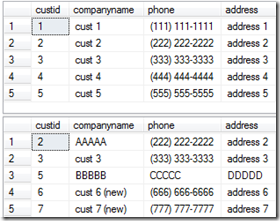sql server 2008语言基础: 再回首之Sql 2008的merge关键字
数据脚本为
IF OBJECT_ID('dbo.Customers', 'U') IS NOT NULL DROP TABLE dbo.Customers;
GO
CREATE TABLE dbo.Customers
(
custid INT NOT NULL,
companyname VARCHAR(25) NOT NULL,
phone VARCHAR(20) NOT NULL,
address VARCHAR(50) NOT NULL,
CONSTRAINT PK_Customers PRIMARY KEY(custid)
);
INSERT INTO dbo.Customers(custid, companyname, phone, address)
VALUES
(1, 'cust 1', '(111) 111-1111', 'address 1'),
(2, 'cust 2', '(222) 222-2222', 'address 2'),
(3, 'cust 3', '(333) 333-3333', 'address 3'),
(4, 'cust 4', '(444) 444-4444', 'address 4'),
(5, 'cust 5', '(555) 555-5555', 'address 5');
IF OBJECT_ID('dbo.CustomersStage', 'U') IS NOT NULL DROP TABLE dbo.CustomersStage;
GO
CREATE TABLE dbo.CustomersStage
(
custid INT NOT NULL,
companyname VARCHAR(25) NOT NULL,
phone VARCHAR(20) NOT NULL,
address VARCHAR(50) NOT NULL,
CONSTRAINT PK_CustomersStage PRIMARY KEY(custid)
);
INSERT INTO dbo.CustomersStage(custid, companyname, phone, address)
VALUES
(2, 'AAAAA', '(222) 222-2222', 'address 2'),
(3, 'cust 3', '(333) 333-3333', 'address 3'),
(5, 'BBBBB', 'CCCCC', 'DDDDD'),
(6, 'cust 6 (new)', '(666) 666-6666', 'address 6'),
(7, 'cust 7 (new)', '(777) 777-7777', 'address 7');
上面的是目标表T, 下面的是源表S。 仔细观察, 发现t里面没有custid为6,7的行, 而且2,5行不一样。
那么, 用merge关键字的操作。 将会在T表中插入S表的custid为6,7两行, 并且修改2,5两行。
--1. 把customersStage表(来源表)的内容的合并到Customers表(目标表)中. 更具体的说, --假设现在还想增加一些还不存在的客户, 和更新已经存在的客户的属性. --仔细观看已有的两张表。 发现目标表里面没有6,7. 并且2,5的属性有改动。 merge into customers as t using customersStage as s on t.custid=s.custid when matched then update set t.companyname=s.companyname, t.phone=s.phone, t.[address]=s.[address] when not matched then insert (custid, companyname, phone, [address]) values( s.custid,s.companyname, s.phone, s.[address]) ;得到结果
--上面介绍了merge子句的两种匹配方式。
-- when matched 匹配时。 when not matched不匹配时。
-- 第三种子句。 when not mateched by source. 用于定义对于目标表的一个行, 在来源表中没有
-- 与之匹配的行时, 应该采取的操作。 一般去情况下是删除。
-- --如果target里面有, 但是源表没有的就删除. 有点类似于inner join的笛卡尔乘积,
-- 左边表里面存着记录, 但是右边表没有. 还是删除掉
现在我们重新新建这两张表。
 发现目标表中有, 但是源表中没有的数据, 那么就删除掉。 发现T表中的1和4 要中枪了。
发现目标表中有, 但是源表中没有的数据, 那么就删除掉。 发现T表中的1和4 要中枪了。
merge into customers as t
using customersStage as s
on t.custid=s.custid
when matched then update set t.companyname=s.companyname, t.phone=s.phone, t.[address]=s.[address]
when not matched then insert (custid, companyname, phone, [address])
values( s.custid,s.companyname, s.phone, s.[address])
when not matched by source then delete
;
好了。 现在回到第一个例子。 这个例子中, 需要更新已经存在的客户和增加不存在的客户。
可是, 在重写现有客户的属性之前, 语句没有检查列值是否真的发生过变化。 也就是说, 即使来源表和目标表完全相同, 仍然要修改客户行。 用and选项能够为不同的操作子句增加谓词条件, 以避免不必要的系统开销。
merge into customers as t
using customersStage as s
on t.custid=s.custid
when matched and (
t.companyname<>s.companyname
or t.phone<>s.phone
or t.[address]<>s.[address]
)
then update set t.companyname=s.companyname, t.phone=s.phone, t.[address]=s.[address]
when not matched then insert (custid, companyname, phone, [address])
values( s.custid,s.companyname, s.phone, s.[address])
when not matched by source then delete
;
本人在长沙, 有工作可以加我QQ4658276








